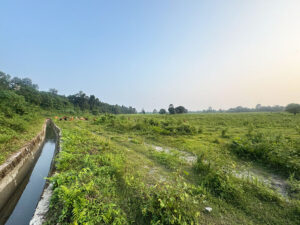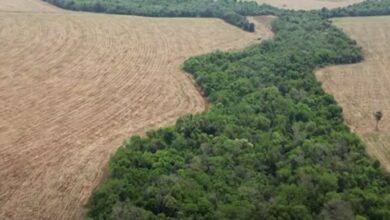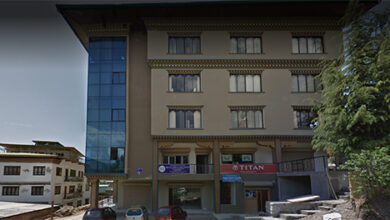Importing foreign workers to Bhutan will help revive wasteland
Sarpang—Sixty-year-old Laja Wangdi, a resident of Gadhen chiwog in Umling, Sarpang, has been leasing his 3.12 acres of wetlands on a crop-sharing basis since he relocated from Pemagatshel in 1999.
Faced with labour shortages, he manages his farm alone. Crop sharing is the only option that has helped keep his land productive rather than leaving it fallow.
Initially, Laja shared his crops with Indian neighbours on a one-third produce basis. However, due to restrictions on hiring foreign labour implemented two decades ago, he now collaborates with a domestic neighbour.
“Through domestic crop sharing, I used to receive 50 tins (15kg) of rice each season, but this year I will only get five tins because the sharecropper couldn’t cultivate the entire land,” said Laja Wangdi. “I am planning to sell the land, as I can no longer do farm work.”
His experience reflects the struggles of many farmers, especially the elderly, in Sarpang, where labour shortages, inadequate irrigation, and wildlife conflicts have led to an alarming rise in fallow land. Some farmers are even being forced to sell their land.
However, with the government considering permitting import of foreign day labourers for farming in border districts, there is a newfound optimism among farmers like Laja Wangdi. Some are hopeful that they can continue cultivating paddy, while others plan to resume farming next season.
Benefits and challenges
The proposed import of cross-border labour is a long-awaited initiative that could significantly support wetland revival. This issue has been consistently raised in gewog meetings and discussed in the Gewog Tshogde, according to the residents.
Currently, farmers are forming groups of up to 20 households to collaborate during the paddy cultivation and harvest seasons through a labour exchange initiative. However, the late planting of crops has often led to poor yields.
The villages are largely populated by elderly residents facing challenges in managing their farms.
Seventy-seven-year-old Pema and sixty-two-year-old Nim Dorji are among those still actively participating in labour exchange despite their age.
“The import of day workers would provide us relief from the laborious task of paddy cultivation,” said Nim, who has leased out his 2.33 acres. “It is difficult to work at my age, but we have no other option.”
Pema recalls that in the past, crop sharing arrangements and seasonal day workers were common, which prevented large swathes of land from being left barren. “If the wage rate is affordable, importing day workers will greatly help households facing labour shortages like mine,” he said, adding that his 2.30 acres of wetland in Gadhen currently remains fallow.

The recently renovated irrigation canal soon developed cracks and was damaged at multiple points
Currently, around 180 of the 230 acres of wetland in Gadhen have been fallow for two years, primarily due to heavy rainfall damaging the irrigation canal. Although repairs were made, the cement walls soon developed cracks at multiple locations.
Despite these challenges, Phurpa Lhamo, 37, has teamed up with five other households to resume paddy cultivation through labour exchange. However, she struggles to find workers, even when she can pay. “My 1.5 acres require about 25 workers for a day, plus lunch and refreshments, which is costly,” she explained.
Gadhen Chiwog, home to around 80 households, has the most productive rice fields in Umling, yet it also accounts for the highest amount of fallow land in the gewog.
Tshogpa Pema Phalay said that the contractor has been notified, and maintenance will be conducted during the winter under the one-year liability period. “The gewog irrigation committee has also written to the dzongkhag engineering sector regarding quality concerns.”
Given the wage differences, residents believe that importing foreign day workerds will be more cost-effective. Currently, domestic labourers in Gadhen and Rijong earn around Nu 400 daily, while wages in Dangling chiwog are higher, at Nu 500 for women and Nu 600 for men.
Mohan Singh Ghallay, 64, from Rijong chiwog, hopes to fully cultivate his three acres of wetland, which have been alternately farmed due to labour shortages. “The gewog also plans to improve the irrigation water supply,” he said.
Dangling Tshogpa Samdrup said that while hiring foreign day workers will reduce the financial burden of high domestic labour cost, providing reliable irrigation water, agricultural machinery, and measures against wildlife conflicts are equally important for reviving fallow lands.
“The government encourages farmers to take up farming, but most cultivation relies on seasonal rainwater due to a lack of reliable irrigation canals,” he said, adding that his chiwog has been identified to pilot chain-link fencing, which has yet to be implemented.
After the gewog administration temporarily restored the 2.5-kilometre irrigation canal from Langkarchhu, four households in Dangling resumed paddy cultivation on eight acres of wetland that had been left fallow last year. Some cultivated paddy, while others grew dal (pulse).
Following consultations with stakeholders, including the Ministry of Home Affairs and the Ministry of Industries, Commerce, and Employment, the Ministry of Agriculture and Livestock will pilot the employment of seasonal day workers this year.
Sarpang has the second-largest area of barren wetland among districts, totaling 981 acres, just behind Samtse’s 1,261 acres. In addition, Sarpang has 1,437 acres of dry land left fallow, ranking it 12th among districts, while Samtse ranks eighth with 2,505 acres of fallow land.





